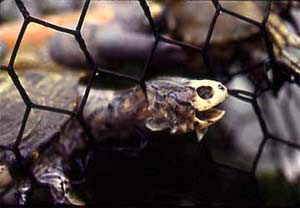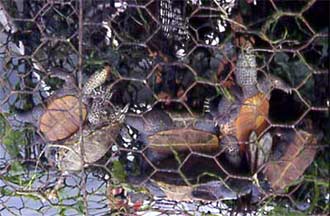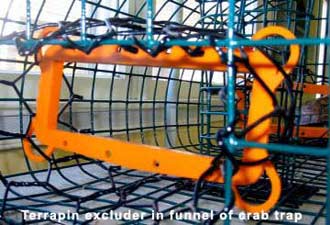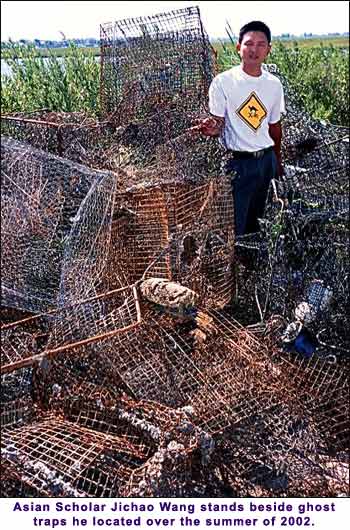
![]() Terrapins and Traps
Terrapins and Traps
Diamondback terrapins are small, harmless turtles that are only found in salt marshes of the Atlantic and Gulf coasts of the United States. Throughout much of their range, terrapin numbers have been declining (Mann, 1995; Seigel and Gibons, 1995; Wood, 1997).
Part of the reason for this decline is the increasing use of commercial crab traps — for commercial and recreational purposes — in the same salt marsh creeks and sounds where terrapins dwell. This is a problem not only in New Jersey but also in other areas where terrapins occur (Bishop, 1993).

![]() In New Jersey, a maximum of 27,565 commercial crab traps were reportedly in use in 2001. This number does not include unreported commercial crab traps or recreational traps also in use. Commercial crab trap use is even more intensive in other states. For example, some 650,000 crab traps are annually set along Louisiana’s coast (Arcement and Guillery, 1993).
In New Jersey, a maximum of 27,565 commercial crab traps were reportedly in use in 2001. This number does not include unreported commercial crab traps or recreational traps also in use. Commercial crab trap use is even more intensive in other states. For example, some 650,000 crab traps are annually set along Louisiana’s coast (Arcement and Guillery, 1993).
- Because terrapins are carnivores they are attracted by the bait fish used in commercial crab traps. As a consequence, terrapins of all sizes (their shells can exceed 8 inches in length in New Jersey) push their way through the entrance funnels of commercial crab traps in order to get at the bait. Unlike blue crabs, which have gills, terrapins have lungs and are air-breathers, just like people. Once inside the traps, many terrapins drown. It has been estimated that a minimum of 14,000 to 15,000 terrapins annually drown in traps set along the New Jersey coast. Crabbers do not want to catch (or drown) terrapins for two reasons:
- There is a widespread belief that once terrapins get inside a crab trap, crabs are scared away and do not want to enter the trap funnels as they ordinarily would.
- The crabbing season (spring, summer, and early fall) coincides with the closed season for taking terrapins, which are currently considered game animals under New Jersey law. Therefore, catching terrapins in traps Is technically a violation of the law and represents an unintentional illegal activity.
- Excluders are highly effective at preventing terrapins from entering commercial crab traps.
- There is no decrease in the number or size of marketable crabs (more than 4¾ inches) caught in excluder equipped traps.
- There is actually an increase in the number of marketable-sized crabs caught when excluders are used. This is because the excluders reduce the dimensions of the inner funnel opening, making it more difficult for crabs to find their way out of the trap once they have entered it.


In view of all the foregoing facts, a new regulation has gone into effect in New Jersey as of January 1, 1998. This regulation states that all commercial-style traps used in waters less than 150 feet wide at low tied or in any man-made lagoon must be fitted with devices designed to exclude diamondback terrapins. These devices may be either rectangular or diamond shaped and no longer than 6 inches wide or 2 inches high. These devices should be attached across the opening at the narrow end of each funnel entrance. This regulation is intended to protect an increasingly threatened natural resource—diamondback terrapins—without detrimentally affecting the catch of New Jersey's crabbers.
The reason that traps fitted with excluders are only required to be used in certain situations is a reflection of the nonuniform distribution of terrapins in coastal waters. Terrapin populations are densest in salt marsh creeks and near marsh banks fringing the open waters of sounds and bays. Terrapins are less abundant in open waters, and are thus somewhat less likely to be caught in crab traps set in these areas.
Moreover, it is the intent of this regulation to require virtually everyone who uses commercial-type traps for recreational purposes (and the best available estimates are that there may be 10,000 or more traps annually used by recreational crabbers in New Jersey) to fit their traps with terrapins excluders. (Note: The regulation discussed here pertains only to the use of commercial crab traps. Crab traps designed solely for recreational use, with sides that flip up when the trap cord is pulled, do not drown terrapins and are not governed by this regulation.
First Aid for Trapped Terrapins
Terrapins can survive for longer under water than humans can because turtles are “cold-blooded” animals. No one knows precisely how long an active terrapin (as opposed to one hibernating in the winter) can survive under water — probably several hours at least, but certainly less than a full day. It is essential that all commercial crab traps be checked at least once a day. Otherwise, all trapped terrapins will drown.
- Sometimes, when a terrapin is found inside a commercial crab trap it will appear to be dead. However, many crabbers know that these seemingly dead terrapins can actually be revived. Here's how to help one of these terrapins to recover:
- Place the terrapin on its belly in the bottom of your boat (or on your dock) so that its shell is tilted with the head end lower than the tail end. If you see water dribbling out of the nose and mouth, this is a good sign that the lungs are draining.
- Try to keep the terrapin in a shaded spot. If the terrapin is placed in direct sunlight on a hot day, the terrapin will overheat and the thermal stress will kill it.
- Give the terrapin plenty of time to revive. The first sign of recovery is usually the wary opening of one eye or the movement of a limb.
- If the terrapin appears to have revived, do not release it immediately. The terrapin needs a little time to recover fully. If possible, keep it in a safe place in a cardboard box or a plastic bucket overnight then release the terrapin the next day.
- Do not attempt to feed the terrapin before releasing it (near where it was caught, if possible).
- Do not put the terrapin in a water-filled container while it is recovering. The terrapin should be kept dry and out of direct sunlight.
LITERATURE CITED
![]()